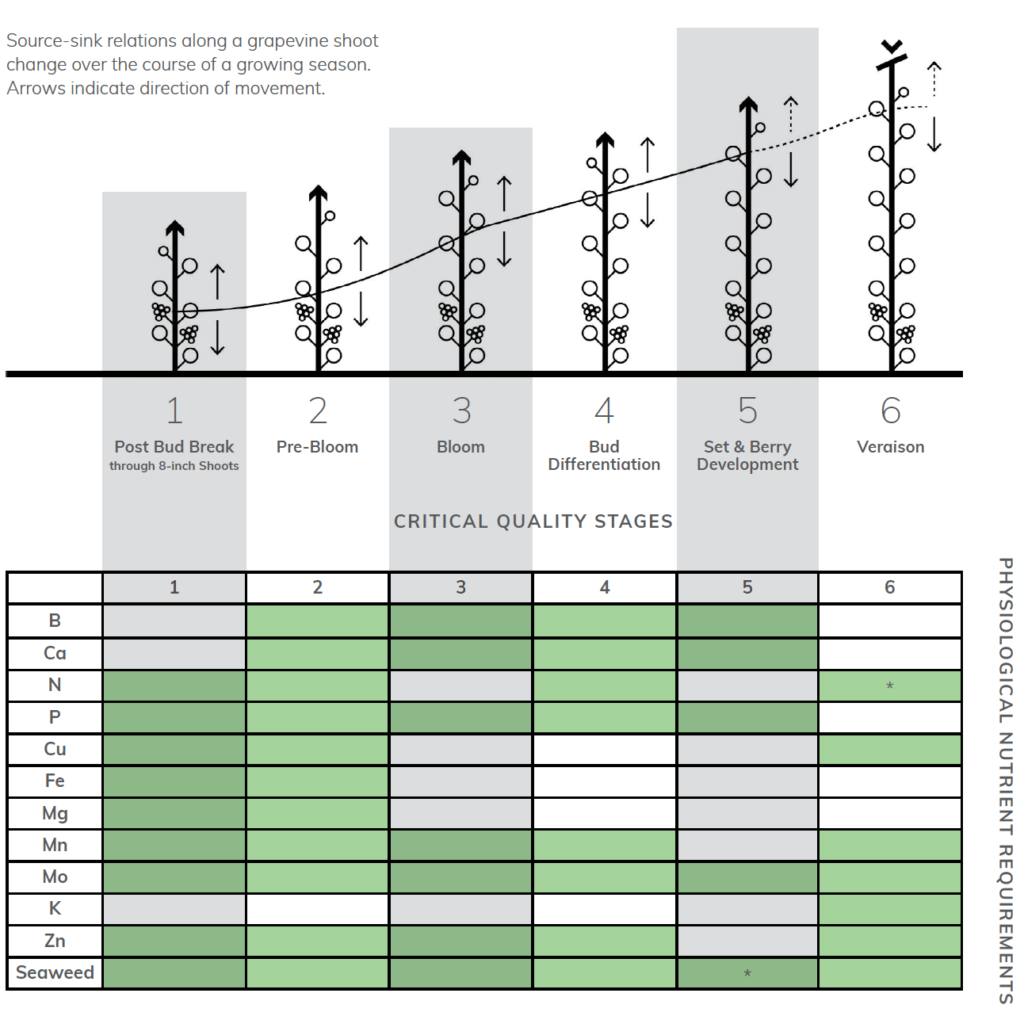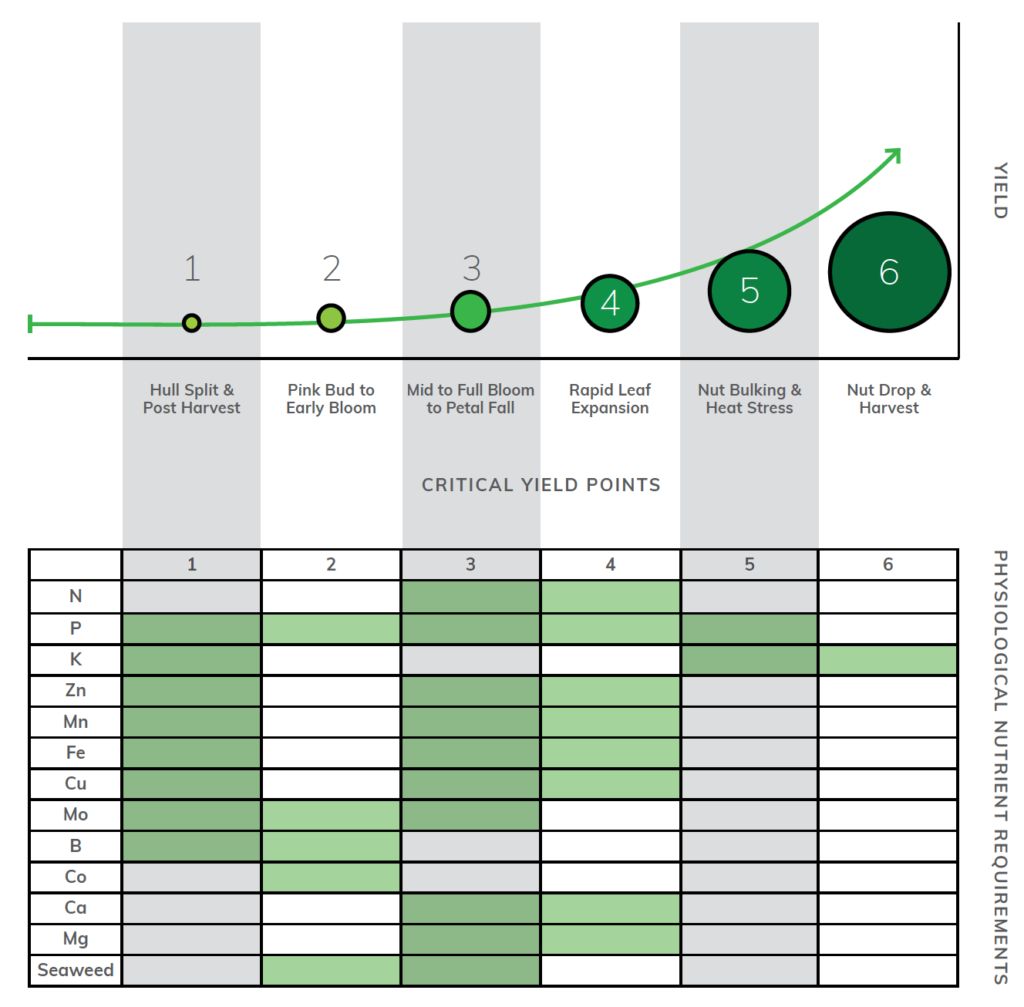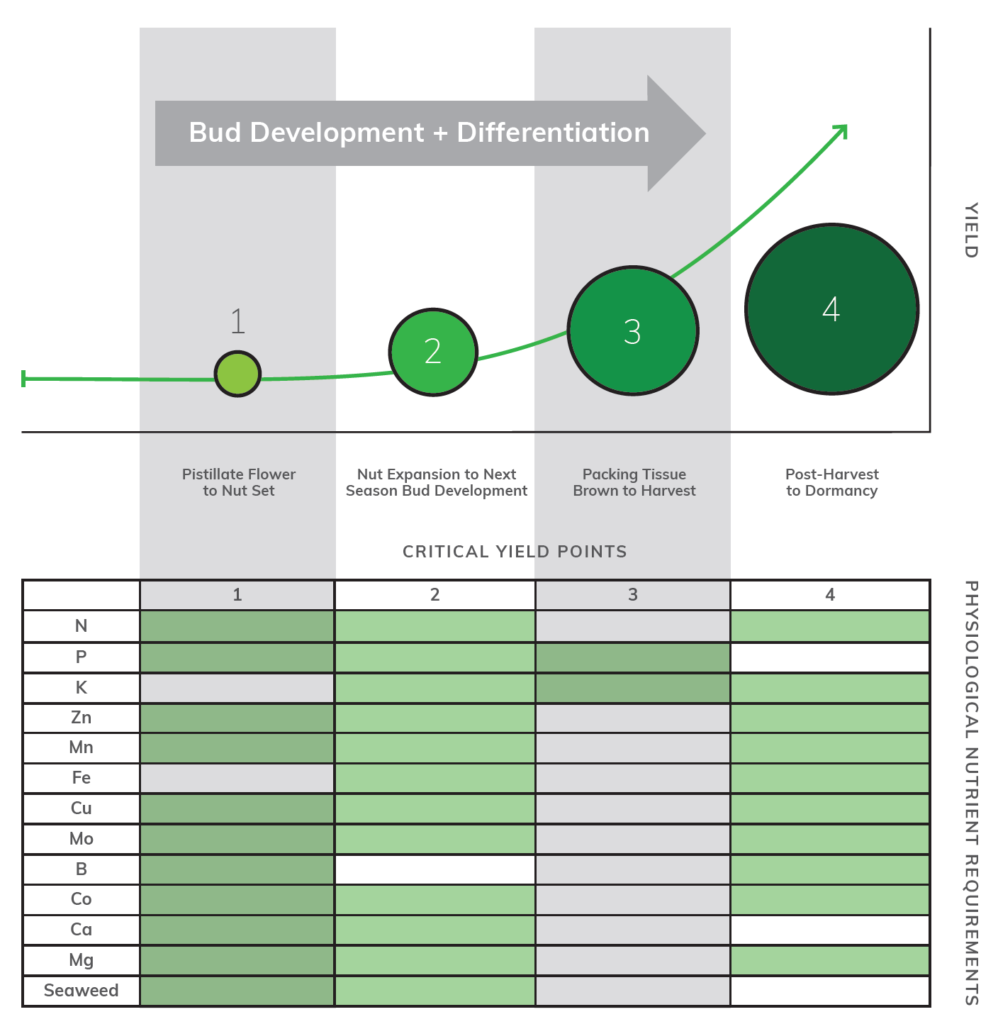Growing Together Spring 2022
Rethink In-Season Crop Nutrition with Attention to Key Growth Stages and Timing
The many challenges facing growers in our area create a lot of uncertainty but also present new opportunities to innovate, adapt and improve current management practices with economically sustainable methods. Integrating a science-driven crop nutrition program targeting key growth stages is one way growers can ease in-season and long-term pain points.
Science-based programs
Science-based nutrition programs enable growers to better support crop development. Grow West is implementing this approach with our grower partners, allocating key nutrients throughout the growing season while keeping budgets in mind. The approach ensures timely nutrient availability, allows for maximum yield and increases overall crop health and vigor. The team has developed resources to help you identify the right products and application methods at key crop growth stages, specifically for grapes and tree nuts. These resources take into consideration specific challenges — like the freeze that hit the northern reaches of Grow West territory and its impact on fruiting wood development in younger tree plantings — and how the right crop nutrition can help overcome them.
Think in terms of the 4Rs: right nutrient, right stage/timing, right formulation and right place. Incorporating the 4Rs provides a complete, more effective nutritional program for growers that accounts for the variability of pre-existing and applied nutrients to ensure field- or vineyard-wide efficiency. In many cases, adhering to the 4Rs depends on critical quality stages (CQS) in vineyards and critical yield points (CYP) in orchards.
Critical Quality Stages in the vineyard
Timing is a big part of meeting vineyard nutrient needs and facilitating optimal crop quality and productivity. Critical Quality Stages (CQS) are key physiology stages of nutrient uptake that affect quality, yield and vineyard health.

Bloom, for example, is a key CQS in a vineyard nutritional program. This growth stage offers a window to maximize the uptake of key nutrients that influence cell division, fruit set, flavor, color and tannin development. Key nutrients to maximize during bloom are:
- Boron (B)
- Calcium (Ca)
- Molybdenum (Mo)
- Manganese (Mn)
- Phosphorous (P)
- Zinc (Zn)
Calcium is imperative in this timing because it supports stronger berry cell walls. Stronger, thicker cell walls provide enhanced color within the berries and increase mouth feel through tannin development. Synergized boron, molybdenum and phosphorous strengthen cell division, which also impacts fruit set.
Critical Yield Points in tree nuts
To maximize the 4Rs in the orchard, Grow West crop specialists have identified a series of Critical Yield Points (CYP) throughout the growing season.
Critical Yield Points are key physiological growth stages that:
- Significantly impact nutrient uptake and use efficiency leading to more economical yields
- Contribute to optimal application formulations and timing
- Promote carbohydrate production and return bloom strength
- Improve overall tree health and productivity leading to sustainable orchard lifespan
- Achieve maximum nut drop at harvest for fewer sticktights and mummies as well as less future navel orangeworm
New tree plantings also respond well to the 4R’s and have CYP driven needs that impact long-term health and productivity. Supporting earlier, stronger growth and faster large leaf size increases photosynthesis which supports root health and development. Tailoring nutrient management programs for young plantings to CYP leads to faster fruit production, the ability to carry heavier crop loads earlier, reduced root disease pressure, increased transplant survival rates, and faster balanced tree growth.
Crop nutrition programs that account for CYP ensure specific nutrients are available and in the right forms during key physiological growth stages resulting in maximum nut size and maturity at harvest. The following examples demonstrate how to best account for CYP to maximize nutrient application efficiency, cost-effectiveness and general uptake for optimal crop vigor.
Optimizing crop nutrition during a key almond CYP
Nut bulking is a key CYP to consider in planning nutritional programs in almonds, especially as it relates to enabling the crop to manage heat stress. When optimizing crop nutrition in this CYP, consider output quality measurements like size, weight and uniform maturity at harvest. Optimal nutrition helps an almond crop better overcome heat and drought stress at this growth stage.

Phosphorous (P) and potassium (K) are critical nutrients during this CYP. Nut bulking increases demand for potassium that supports stomate function, facilitates photosynthetic activity and builds phosphorous storage within the tree. Late-season carbohydrate availability — a product of photosynthesis provided by potassium — has a tremendous impact on the following season’s nut set.
During early-season CYP, carbohydrate production is driven by leaf expansion and chlorophyll production that build a plant’s photosynthetic capabilities. More large, chlorophyll-filled leaves promote increased photosynthetic activity that, in turn, leads to higher levels of carbohydrates in the tree. Ultimately, optimal carbohydrate production during the nut bulking stage leads to better return bloom and larger nuts the following season.
Walnut CYP for nut expansion to next season bud development
Developing walnut buds and shoots require sufficient micronutrient availability for vascular development, making this a key growth stage to watch in identifying the right crop nutrition program. Nutrients that influence yield potential during this CYP are:
- Boron (B)
- Calcium (Ca)
- Cobalt (Co)
- Copper (Cu)
- Iron (Fe)
- Magnesium (Mg)
- Manganese (Mn)
- Molybdenum (Mo)
- Nitrogen (N)
- Phosphorous (P)
- Zinc (Zn)
Adequate supplies of early-season calcium enable nut cells to expand to their maximum size while retaining cellular strength, and magnesium, cobalt, manganese, iron and copper applications promote photosynthesis and carbohydrate production. In-plant carbohydrate production also improves when applying these products at the right time in the CYP. Increased carbohydrates help reduce alternate bearing, increase nut size and reduce May/June drop.

Communicate your nutrient needs to your Grow West team
The Grow West team leverages science-driven programs to develop nutrient management plans synchronized with your crops’ critical yield and quality stages. The result is season-long balanced crop health, production and return on investment. Grow West PCAs and technical advisors are ready to support growers in navigating through existing crop nutrition obstacles and improving current programs to achieve economic sustainability. As your growing partner, we will continue to remain strategic and adapt to what lies ahead.
